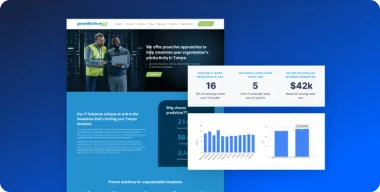Are you all sitting comfortably? Okay, then I’ll begin.
Once upon a time, when the internet was new and bright – lived Arthur, a poor but honest IT repairman, who’d spent his savings following his dream of becoming a computer wizard to all who needed his help. But no one ever came to him with their computer problems and he had no idea what to do.
So, when he was down to his last $100 dollars, he sorrowfully decided he’d have to return to the the hell that was Window’s Vista customer support. He was about to make the call, when from the corner of his eye a dusty old floppy disk, caught his eye. He decided to reformat it and when this was done, a great genie came forth and stood before him in the strangest of garb…He began to speak…
Are you asking what’s going to happen next? Can you relate to Arthur’s plight? If you’re answering yes to then, you’ve just had a little taste of the power of storytelling. A power that can make the difference between your website thriving or failing.
Don’t worry, we’ll come back to Arthur’s genie, (if you can’t wait, scroll to the bottom) but what we are trying to show you is how an engaging story can draw people in. If they want to know what happens next, they’ll click and keep reading. Remember how your first grade teacher knew just when to stop reading, leaving you on the edge of your seat wanting more? This is exactly what you need your website to do – grab people’s attention and get them clicking.
We’re hardwired to love stories. Hunter-gatherers would tell tales around the campfire, to entertain, educated and enthrall – and we do it today with plays, books, television and movies. The internet is just another way that people seek out stories.
So when you’re planning your website, be it brand new or a revamp, put yourself in the role of a story-teller. Decide what the stand-out facts about your business are, consider your audience and their needs and interests, and think about how you can grab them before they click away? Well here are three ways.
1. Draw readers in
The best marketing is storytelling. Whether you’re writing a post for Facebook or a landing page for a new service try and tell a story rather than simply trying to sell and push your services on readers. People are now so used to advertising in their everyday lives that they easily tune it out. A story is the opposite and people tend to tune in. Here’s why:
- Stories are easier to read and can simplify dry or complicated subjects.
- Stories appeal to us at an emotional level.
- Stories persuade people more than dry facts can.
It comes down to how our brains process information. A list of dry information merely activates the language processing parts of our brain. A story, with its rich imagery and description, affects more parts of the brain. If we are told about a delicious dish in a restaurant, our sensory reactors activate.
A dreary site with some contact details, stock photos and some bland facts about your company won’t have this sort of effect. And what’s more, you’re competing with the ever-changing world of the web. This is where people come for fun as well as services and their shortened attention spans crave engagement and entertainment. On top of that, you’re up against your local competitors who are selling similar services and products as you. So its your story that will make you stand out.
2. Make a human connection
Telling a story is an age-old way of building relationships and brings people together. You don’t need award-winning web designers, video-teams and Pulitzer Prize winning writers. People are not looking for that in small or medium-sized businesses. But if you communicate the story behind your brand, you make a more important connection, a human one.
Let them know how you got started
Is it a family company established by a venerable ancestor from humble beginnings? Are you a new start up following a dream or did you start your company having spotted a gap in the market? Have you invented a fantastic new product? Every business has a beginning and people are interested in how things get going and how they’ve grown. Tell them.
However your company started, its story is unique. So use it in your emails, brochures, and direct mail, as well as on your website. Remember Victor Kiam with his catch phrase for Remington? “I liked the shaver so much, I bought the company.” Everybody does. It was his story and people loved to hear it. He even recorded it in the local language of every country he sold the razor in. Stories can even cross language barrier borders.
Give your business a face
People are fascinated by people and want human-to-human connections so let your customers put a face to your company. Add staff photos and biographies and let them tell their own stories. What makes them get out of bed and keep coming to work every day? What are they passionate about?
Start a conversation
Unless you are working in an very technical industry and selling to people in the same sector, it is not a good idea to be too formal or to use too much jargon when telling your brand story. You need to sound authentic and show that you believe in your products and services. People can spot false promises and they can hurt your brand so be honest and transparent.
Tell your customers’ stories too
Everyone likes to be part of a story and you’ll find that many of your customers are happy to let others know how they’ve engaged with your company. Make them shine via testimonials, customer success stories or in-depth case studies. These stories create a human interest element and help to make a connection with other customers.
3. Incorporate storytelling into design
Remember that storyteller in his cave, enchanting his audience with tales of hunts and heroes? You have a great advantage over him, for as well as words, you can use pictures, visuals and even video to enhance your storytelling. After all, our brains are hardwired to make sense of visual information and the interactive nature of a website means you can tell a story on several levels with pictures, sound, video and copy, all delivered in an attractive package. And the current fashion for websites that scroll works to your advantage.
Scroll your story
If you take a look at many modern websites (check out some examples here and here) you’ll see that they adapt themselves to storytelling brilliantly, with a linear narrative. A scrolling website takes people on a journey. The chances are your company specialises in several areas, and may also be running campaigns, offers or promotions. A scrolling homepage allows you to split what you do into sections and you can keep the narrative linked as the reader scrolls down. The advantages to this are:
- They keep the visitors reading. Scrolling home pages encourage us to engage more by rolling down the page. Clever design, color schemes and visuals linking one section to another keeps things visually interesting while cleverly telling the story that takes readers to the bottom of the page, by which time they’re ready to take action.
- Familiarity. It’s second nature to navigate pages by scrolling downwards – this is why there are those handy rollers on the tops of our mice. A scrolling homepage takes advantage of this habit of scrolling down and it also means you don’t have to cram all your information at the top of the page.
Start now, not once upon a time
Remember. A good story stimulates people, they build pictures in their head, remember your company, take action and most importantly will pass the story on to others. And If the story your website tells is gripping enough, it will always be passed on by social media and good old fashioned word of mouth.
There’s much more Pronto can tell you about how to make an emotional connection with your customers but these are stories for another time. Perhaps we’ll get round to telling them some day, so stay tuned. Oh, and if you’re wondering what happened to our IT man Arthur!
…”I am Pronto, the genie of the disk, and I bring you great wisdom that will make you a powerful and wealthy man…for a nominal monthly fee.” And the genie was as good as his word, revealing to Arthur the secrets of a great website – and soon all of his problems were solved. Customers came flocking to his door with their dodgy hard drives, software worries and evil viruses – Arthur the IT man had more work than ever and soon his pockets were stuffed with gold and he lived happily ever after…
The End




